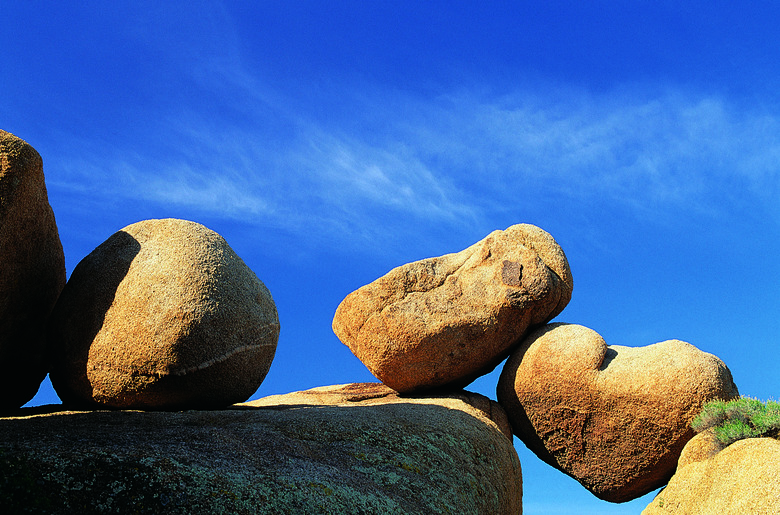Definition Of Spheroidal Weathering
How does spheroidal weathering occur? A type of exfoliation, spheroidal weathering occurs as a result of both physical and chemical influences. Also known as onion skin weathering, concentric weathering or spherical weathering, spheroidal weathering produces rounded boulders or round shapes within rock outcrops. Spheroidal weathering often results in interesting and unique geological features, such as the Giant's Causeway in Northern Ireland.
How Does Spheroidal Weathering Work?
How Does Spheroidal Weathering Work?
The term onion skin weathering helps explain how this process works. Due to a combination of physical and chemical factors, layers of rocks crack and fall off like layers of an onion in spheroidal weathering.
Weathering usually occurs from the outside of a rock toward the center. However, joints and fractures in rocks allow for water to enter. When water inside joints and fractures freezes, it expands and exerts pressure, pushing the rock apart. This particular process is called frost wedging or freeze-thaw weathering, a type of physical weathering.
As the joints and fractures widen due to frost wedging, this creates more surface area that is vulnerable to both physical and chemical weathering. Often, water contains compounds like carbon dioxide, making it more acidic. The surface area of rocks also reacts with elements in the air to form new minerals. The exposed surface area inside rocks caused by frost wedging makes them more susceptible to chemical weathering from acidic water and compounds in the environment.
As larger rocks are broken into smaller cubes due to the interactions of these chemical and physical influences, the rate of weathering is greatest at the corners, edges and faces of the rock cubes. This eventually leads to the formation of a spherical shape, such as in the examples below.
Examples of Spheroidal Weathering
Examples of Spheroidal Weathering
Spheroidal weathering affects both individual rocks and large outcrops of rocks. The spherical form of giant boulders is caused by this type of weathering, and so are the rounded forms at the tops of mountains like Mount Rushmore. The giant dome of Georgia's Stone Mountain is also caused by spheroidal weathering.
Sometimes spherical shapes are embedded within larger outcrops of rocks, such as at the Externsteine rocks in Germany. In other places, the combination of chemical and physical weathering causes rocks to erode into towering columnar shapes, like those at Devils Postpile in California.
The exfoliation of layers of rock is often seen in outcrops of slate and limestone, rocks that break easily along parallel lines. Foliation is a geological term that refers to the presence of layers in metamorphic rocks, and some foliated rocks lose thin layers of rock easily, making them more likely to be affected by spheroidal weathering.
The way that rocks and outcrops change shape over time is due to a combination of factors, including length of time, all of the chemical and physical forces that are acting on them and the minerals they are composed of.
Types of Rocks Affected
Types of Rocks Affected
Some types of rocks are more prone to spheroidal weathering. These include basalt, granite, dolerites, andesite and some sandstones. This is because these rocks contain minerals that are less chemically stable at the surface of the Earth, making them more susceptible to weathering.
Rocks and rock forms that tend to have joints and fractures are also more likely to be affected by spheroidal weathering. These cracks allow water to penetrate the rocks and expose more surface area, and the differential weathering caused by expanded joints will often lead to spherical rock forms on large and small scales.
Over the course of thousands of years, the interaction of chemical and physical weathering has created many interesting and distinctive spheroidal land forms on the crust of our planet. Look around next time you go hiking and see if you can find a rock shaped by spheroidal weathering.
Cite This Article
MLA
Sloane, Christina. "Definition Of Spheroidal Weathering" sciencing.com, https://www.sciencing.com/definition-spheroidal-weathering-23142/. 20 October 2021.
APA
Sloane, Christina. (2021, October 20). Definition Of Spheroidal Weathering. sciencing.com. Retrieved from https://www.sciencing.com/definition-spheroidal-weathering-23142/
Chicago
Sloane, Christina. Definition Of Spheroidal Weathering last modified August 30, 2022. https://www.sciencing.com/definition-spheroidal-weathering-23142/
